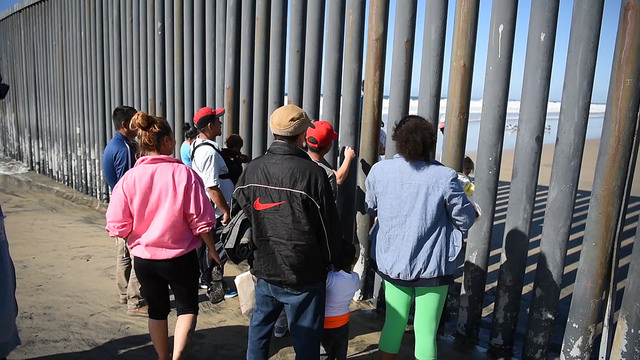Students react to Southern border crisis
Daniel Arauz/Creative Commons/flickr
Honduran migrant asylum seekers arrive in Tijuana, Mexico. The border late last month erupted in scattered violence as the migrant caravan tried crossing into the United States to seek political asylum from violence in their home country.
December 4, 2018
DHS’s Latino students say it’s painful to watch images of Honduran migrants attempting to cross into the United States and facing tear gas from U.S. Border Patrol.
Tijuana, a city located in the north of Baja California in Mexico, is typically known for its bustling main street, wrestling arenas, and sandy white beaches. Recently, however, a caravan of young men, women, and children migrants from Central America, mainly Honduras, reached Tijuana with the goal of requesting asylum within the United States.
As one of the most diverse high schools in Connecticut, there are students and faculty who are on both sides of this dilemma.
Several Latino students interviewed shared their own experiences related to the situation at hand and immigration as a whole.
“It’s devastating. I’m Hispanic and I have friends who have crossed the border or their family has, and to know that someone that I know has been in that situation is devastating,” said senior and Latino Club President, Esteisy Reynoso.
Another Latino Club member, senior Jessica Tenezaca, related her experiences with immigration within her family as well. “My aunts, uncles, cousins—they’re all immigrants. They all came here from Ecuador through Panama and Mexico and across the border.”
“It’s really tough coming here. My aunt was pregnant with my cousin when she crossed the border; it was very difficult for her to make that journey here,” Tenezaca continued.
Latino Club holds its meetings every Wednesday, and its purpose is to “focus on our roots and bring a part of our culture to the school because it’s very easy to lose yourself in a school so big as ours,” according to Reynoso.
The migrants traveled in this caravan with the goal of requesting asylum. The term asylum is used to refer to when a nation grants protection to someone who has left their native country as a political refugee.
There are two primary ways in which a person can legally apply for asylum in the United States: the affirmative process and the defensive process, according to the U.S Citizen and Immigration Services. Asylum seekers who arrive at a U.S. port of entry, such as the migrants at San Ysidro, usually apply through the defensive process.
Throughout this painstakingly complex and lengthy process, often taking years, immigrants must prove that they meet the definition of a refugee in immigration court. Many state fear or persecution as reasons for seeking asylum.
When it comes to finding a solution to this crisis, views are split across the country. The Trump administration is currently looking into limiting and placing a cap on the number of immigrants who can request asylum.
Junior Alec Stanton, a member of DHS’ Young Republicans club, said that a wall separating Mexico and the United States would be a good idea and would act “like a membrane. Let the good [people] in and the bad [people] out.”
The rest of the Young Republicans club declined to comment.
Jose Rojas, the advisor of the Latino Club, agreed that immigrants should respect the existing policies in place within the United States. “The law must be followed. Immigrants should come into the United States legally.”
The United States Border Patrol closed the San Ysidro port of entry from Tijuana to San Diego on Nov. 25.
Migrants protested the border closing, some even throwing rocks at the U.S. Military. In response, U.S. Border Patrol agents released tear gas on the migrants, forcing them to retreat deeper in Mexico.
Tear gas is classified as a gas that causes severe irritation to the eyes. It is commonly used to break large groups in riots or protests, with the intent of forcing the crowds to disperse. The issue with the gas is that it was released in Mexico, not in the United States.
The caravan has increased to around 5,000 migrants, most of whom are women and children.
Immigration has long been a topic of heated discussion in America, especially with the rise in deportations over the past decade during the Obama and Trump administrations.
The ICE agency, the section of the U.S. Department of Homeland Security tasked with enforcing deportations and regulating illegal immigration, plays a major role in the immigration situation as well.
However, ICE has drawn its own share of controversy within the nation for putting immigrant children in cages at immigration camps.
At the end of the day, despite personal opinions and experiences, it all trickles down to a decision that this nation must ultimately enact. But to do so, Reynoso believes one question must be addressed:
“Why are people coming here in the first place; why don’t we, the U.S., do something to help our neighboring countries?”























